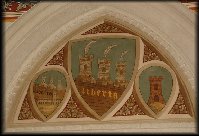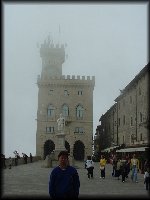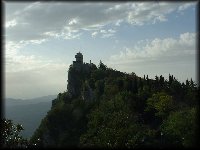
San Marino – this is a tiny
landlocked republic with size 60 sq km and 22,000 inhabitants, totally
surrounded by Italian territory. Accordingly
to legends, it was founded in 301 A.D. (and so celebrating 1700 years of
foundation this year), by a hermit stonecutter named Marinus, from the island of
Rab, in what is today Dalmatia, Croatia. Well,
Marinus and his mate Leo didn’t actually intended to come here at first –
they were working in nearby Rimini, where Marinus got into trouble with an
amorous lady who claimed to be his wife and then exposing him as a Christian,
and so they fled to the remote Mt Titano to avoid her advances.
Upon arrival, Marinus’ donkey was eaten by a bear and he convinced it
to take-over his donkey’s job (an early example of job expandability). Marinus’
female stalker chased him to these remote mountains where she went mad and died
when she saw the bear working for Marinus, so saving Marinus from maintenance
payments. The event made Marinus
famous but the local landlady realized that Marinus had been working on her land
and so sent her son to deal with the Dalmatian squatters.
Her son dropped by, confronted Marinus, and promptly went mad.
The landlady quickly apologized to Marinus, converted to Christianity and
gave the whole mountain to him; and miraculously her son recovered.
Since then, Marinus and his
buddy Leo were declared saints, and a community grew up around the monastery
built by Marinus, while his friend Leo set up another community nearby named San
Leo today. The new city was named
after Marinus, and soon became an independent republic incorporating a few
surrounding towns. Tiny San Marino
soon realized that if they stay quiet and insignificant in their remote mountain
home, everybody would forget about their existence, thus avoiding the messy
warfare that were preoccupying surrounding Italian city states.
Even then, the world remains a dangerous place, and several foreign
policy near-misses nearly ended its independence.
Two of these deserve mention here.
In 1797, San Marino was
surrounded by Berthier, Napoleon's general, who demanded the surrender of a
bishop who was Napoleon's enemy, and threatened to invade if the demand was not
complied with. San Marino played the delay tactic, saying that it would comply,
and the bishop managed to escape in the meantime. A smart Regent Captain (one of the two co-heads of state)
quickly secured the friendship of Napoleon, who not only spared the republic
punishment for its disobedience but also offered to expand its territories,
grain and cannons (only the grain was delivered).
Tempting it might have been, but the ever-wise Sanmarinese turned down
the offer, thus saving themselves from the negative consequences following
Napoleon’s defeat.
Event two was no less serious but certainly ensured the independence of the Republic after the unification of Italy. In 1849, Giuseppe Garibaldi, the Italian revolutionary who fought for unification of the Italian states, escaped into Sanmarinese territory with 1,500 men when they were defeated by Papal and Austrian forces. Garibaldi secured the friendship of a Captain Regent who agreed to assist provided that Garibaldi did what he could to prevent San Marino from getting into armed conflict. So Garibaldi disbanded his forces and then slipped through the blockade imposed by 12,000 Austrian soldiers to escape from San Marino with 150 men. Of the rest, some stayed on in the republic while others marched into battle outside the border with severe casualties. Angered with San Marino’s assistance for Garibaldi, Austrian forces violated San Marinese borders causing some mess. Fortunately, France under Napoleon III intervened and saved the San Marino from being occupied. Years later, Garibaldi finally achieved the unification and independence of Italy, and was most thankful for San Marino’s help in those tough years. And so San Marino the political anomaly retained its independence while the other large and small republics, duchies and kingdoms on the Italian peninsula were all merged into the newly formed Kingdom of Italy.
 |
 |
 |
| The three towers of San Marino, its national symbol | The Government House | The Second Tower of San Marino |
In both cases, San Marino’s
independence was threatened because it harboured political refugees.
San Marino’s freedom was preserved more often than not because it had
avoided taking sides in obvious ways, buying its time through careful
maneuvering and delaying taking action, until the controversial figures had left
its territory. Matters became
difficult when Mussolini came to power in Italy, and San Marino’s Fascists
gained control as well. The latter
was overthrown only when Mussolini was kicked off his post, and before that
occurred, San Marino did join WWII – on the side of the Axis powers.
The British even bombed the nation once, causing 60 deaths in an air
raid. During the war, 100,000
people took refuge in the Republic, which then had only 15,000 people.
This act of compassion, as well the historic events described, are
enthusiastically made known to every visitor to the Republic.
Even Lincoln once wrote a famous letter praising the country as “one of
the most respectable in all history.” In fact, the moment one reaches the
border, an overhead banner proclaimed in Italian, “Welcome to the Ancient Land
of Liberty”, although one might argue San Marino was more often lucky than
not, and its actions were largely made in self-preservation rather than
motivated by notions of freedom and liberty.
The road became hilly as we
drove inland toward San Marino. Across
the near-invisible border, we found ourselves on winding hairpin roads.
As in Andorra, though to lesser extent, there were many hotels and
buildings along these mountain roads, certain denseier than the surrounding
regions of Italy (and in Andorra’s case, France and Spain).
Unfortunately, it was a foggy day, and we could hardly admire the famous
skyline of this mini-state.
We parked our car and proceeded to explore the “capital city”, also of the same name. The walled city looked unusually clean, perhaps even sparkling clean. The whole place was sardine-packed with souvenir shops and day tourists from the seaside resorts around nearby Rimini. We walked around its mediaeval streets, visiting old squares and the national museum. The Government House looked like a mini fairy tale castle. This is the HQ of the Government and the Parliament. The Sanmarinese have a strange form of government. Terrified of any potential abuse of power, they have two heads of state, called the Captain Regents, who kept watch on each other. Any executive decision has to be approved by both Captain Regents. Compromise is necessary when they disagree with each other, or the country goes into constitutional crisis. They are elected from the parliament of 60 members and could only serve for 6 months, from 1 April and 1 October each year. Once they have served one term, they cannot serve again for 3 years. After every term, a special open court is held for 3 days during which citizens may bring to court any unhappiness that might have been caused by the Captain Regents. Wow! Just imagine a Clintonesque presidential impeachment trial every 6 months!
The “City” of San Marino is
full of shops selling tacky souvenirs and toys, minus hefty Italian taxes the
tourists – mostly Italian – pay at home.
China-made toy guns and rifles appear to be the local specialty, plus
fake Swiss knives at cut-throat prices. Briefly
flirted with the idea of getting one but I don’t fancy getting arrested on the
flight and having fighter planes escorting us back to the airport.
Other merchandise were of lesser taste, in particular, a noisy farting
toy pig (with unusually large bums) that burst out loud but thankfully odorless
farts whenever someone passed by.
We had late lunch at an
overpriced restaurant (and terrible food) overlooking the cliff-sides with
supposedly panoramic view. Yeah,
they say you see the Croatian coast on a clear day, but given the fog we might
as well have stayed in London. Indeed
the sarcastic Italian waiter, who emphasized that he’s Italian and not
Sanmarinese, said that “there’s nothing original in this country, not the
food, not the drink, not the stuff you see in the shops, and even the fog is
British!” Well, typical
complaints of migrant workers...
After lunch, we headed for the
cliff-side hotel where we had our reservation, or so we thought where we had our
reservation. Well, these crafty
people said they were all full and no, no reservations.
We asked the tourist office for assistance.
Hmm… that’s difficult for the next day is the San Marino Marathon and
participants have taken up all the rooms. In
any case, the helpful lady rang around all the hotels in the Republic for us. Bad news after bad news.
Everyone appeared to be full, until we reached La Tina, a hotel more than
10km from the city of San Marino, located just within the border of the Republic
with Italy. That’s not ideal but
the hotel was in San Marino nevertheless. G.’s
rule for having “done” a country is that one has to stay at least one night
there. At least La Tina is on
Sanmarinese soil.
And off we went to La Tina,
through a less travelled winding road to the south. Here we entered the non-tourist San Marino.
No more souvenir shops and fancy hotels, but a local inn with rooms and a
restaurant. And lots of friendly
non-English speaking locals watching Italian soap and al-Jazeera
shots of Kabul scenes.
We had a wonderful meal of endless rounds of antipasta and local steak,
and excellent red table wine, not to forget a soothing glass of Moscato di San
Marino (yes, our first local product!), all for a reasonable price – can’t
remember how much, the number of zeros beat me – so you know how eagerly I
await the Euro.
A peaceful night.
This place is probably less spooky given the saintly name of the country!
On Sunday morning, we woke up early and then set off for the City of San
Marino. This was a cool clear
morning with bright sunshine. Here
one have a full view of the three fortified towers of San Marino – symbols of
the Republic - stretched across the top ridges of Mt Titano.
We returned to the capital, conquered two of the towers, snapped a few
photos, and then set off for La Bella Italia.
Back to the Italian lowlands
again and suddenly the fog engulfed us. We
drove to the city of Rimini, all the way to the Adriatic coast.
Here on the empty foggy beaches which only two months ago played host of
millions of half or near naked Italian, German and British sun-seekers, we
briefly toyed with the idea of driving all the way eastwards to Ljubljana,
Zagreb, and maybe fly back from Pristina via BA’s new direct flights between
London and Pristina.
We drove northeast along the coast, entering the outer rims of the Po Delta region. This was once a swampy region of disease and nasty spirits, but Mussolini began huge drainage programmes that turned parts into farmland. Parts of the remaining swampy wilderness are today an UNESCO listed world heritage site.
Our target was Ravenna, the
fabled city (also UNESCO-listed) which was briefly capital of the Western Roman
Empire and an outpost of the Eastern Roman Empire. Threatened by the barbarian
invaders, the Western Roman Empire moved its capital to this swampy outpost in
early 5th century AD, and even then it fell in 473 AD.
The subsequent Ostrogothic kings built great monuments here and the
Byzantines who later took over turned it into a treasure throve of Byzantine art
and architecture, complete with the most wonderful collection of mosaics
unmatched even in the core Byzantine world of Greece, Anatolia and the Eastern
Mediterranean.
All roads lead to Rome but
Ravenna, briefly the alternate to Rome, was certainly not road-friendly to us.
We drove round and round in circles, trapped in a Sunday traffic jam,
trying to locate the monuments of Ravenna.
When we finally found them - ancient
tombs and Byzantine churches which are more commonly found in Greece and further
east - we were amazed by the brightly coloured Byzantine mosaics, all of which
put the fading but equally famous (and UNESCO-listed) mosaics of Paphos (Cyprus)
and Volubilis (Moorocco) to shame. It’s
hard to believe that these are one and half millennium years old and yet look as
though they were commissioned yesterday. Amazing
that they continue to illuminate what is otherwise a boring modern industrial
city.
We sped along the highway, rushing all the way back to Bologna Airport, where we spent an atrocious five hours waiting for the plane to sort out its faulty computer systems. As we waited, impatient Americans and tight-jacket businessmen debated the merits of rushing to Milan and fly out from there the next morning. We could hardly have expected that a SAS flight would crash on that Milan runway the following morning in deep Lombardian fog, killing more than a hundred. Possibly more delays for those who actually went over to Milan. Before long, news came about the start of the war in Afghanistan, through the modern day miracle of SMS mobile text messaging (Kenneth, thanks!). As bombing raids flattened the already well flattened cities of that distant Central Asian land, I wondered about the three towers of San Marino and the many near misses they have faced in history.
Use these books!
 Lonely
Planet: Italy
Lonely
Planet: Italy
Helen Gillman, Damien Simonis, et al
 Bologna
& Emilia Romagna - Cadogan Guide
Bologna
& Emilia Romagna - Cadogan Guide
Dana Facaros & Pauls Michael
Click here to send your comments to Tan Wee Cheng, Singapore
Click here to visit the author's homepage with tonnes of other travel stories!